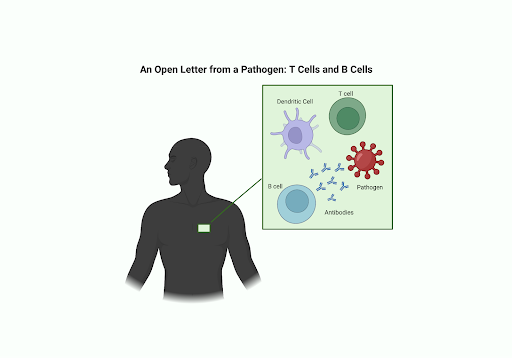An Open Letter from a Pathogen: T Cells & B Cells
By Ariane Tsai, C2ST Intern, University of Illinois Urbana-Champaign, Institute for Genomic Biology
Do you ever wonder how our bodies protect themselves from threats?
Not only are our bodies constantly under threat from the outside world, but they also naturally produce cells that could be harmful, like cancer! Thankfully, our bodies have built up their own defense systems to fight off these dangers. In this article, we will take a closer look at an aspect of the immune system called adaptive immunity, where T cells and B cells work hand in hand to eliminate pathogens from our bodies.

An open letter from a pathogen:
As a pathogen, I have but one simple goal: to survive in the human body and to multiply. To do so, I must evade all the attacks from the human immune system.
Recently, I encountered a suitable human candidate to complete my endeavor. Feeling like I was strong enough to take on the immune cells, I entered the human’s body. As soon as I ventured inside, I was spotted by a dendritic cell on its usual patrol in the bloodstream. It tried its best to engulf me, but I survived. However, it did take a piece of me from my skin surface–the antigen*–and that’s when I realized that I was in for a longer battle. The dendritic cell decided to show my antigen to his friends – the naïve T cells. Based on the information presented, the naïve T cells start to divide (“proliferate”) and take on different roles (“differentiate”) to attack me. The naïve T cells became helper T cells–these cells have the ability to summon more “help” from the B cells. And when the B cells came, they made antibodies* to bind and immobilize me, but even with their best efforts, I survived.
This is when the story gets good and when I realized I was close to victory. I spotted a perfectly healthy cell and successfully invaded it. But before I knew it, the cell recognized me as an intruder and started to send out distress signals. The T cells realized they were losing the battle and decided to turn some naïve T cells into cytotoxic T cells. The cytotoxic T cells realized that it was too late to save the invaded cell and started to release these chemicals, or destructive enzymes, to signal the cell to self-destruct (“apoptosis”). And for reasons beyond my understanding, the cell listened. When the cell destroyed itself, I also went down with it.
Seeing that I was no longer a threat, the regulatory T cells informed the helper and cytotoxic T cells to stop working and leave the battle scene. The cytotoxic T cells then changed their roles again and became long-lived memory T cells so they could respond quicker the next time they saw me. The B cells decided to do the same thing and became memory B cells, but what I did not know was they had already started this process during our heated battle.
While this letter signifies my failure and demise, make no mistake, I will come back stronger and better next time!
*antigen– proteins that are present at the surface of pathogens. Immune cells recognize the shape of antigens and trigger the appropriate immune response.
*antibodies– proteins produced by the b cells to immobilize pathogens through binding to the pathogen’s antigen. Since each pathogen has its own unique antigen, antibodies are made with great specificity and affinity.
For a much deeper dive into the functionality of B and T cells: